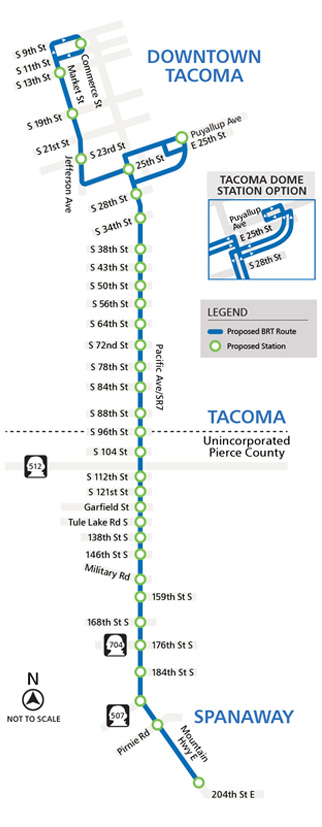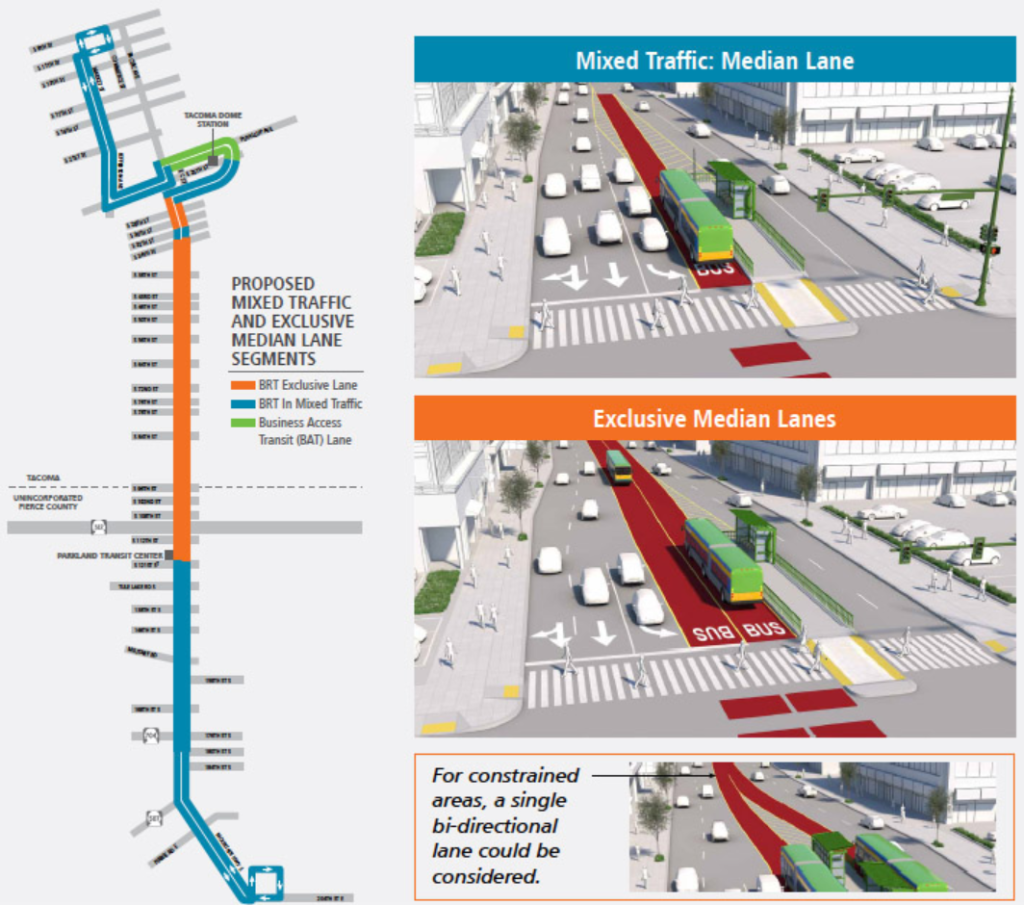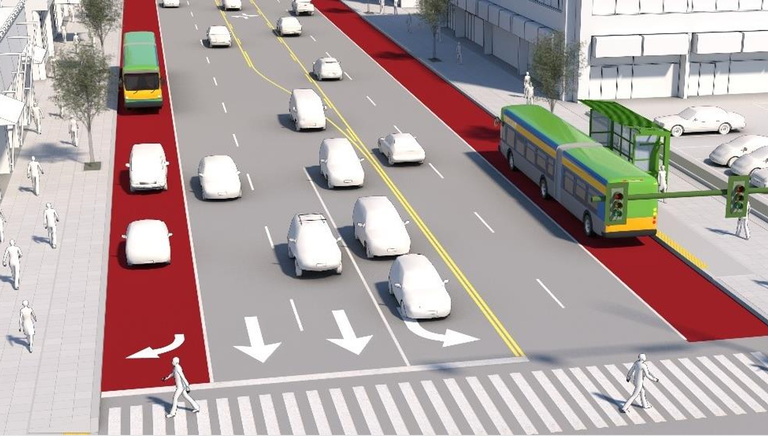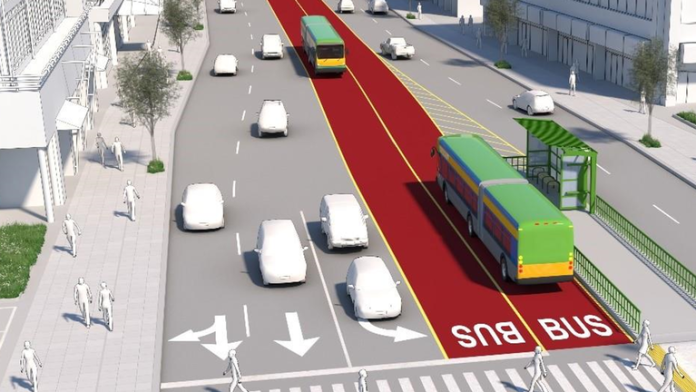Pierce Transit is moving ahead with a hybrid design for 14 miles of bus rapid transit (BRT) on Pacific Avenue, including 3.6 miles of center-running dedicated lanes. The Pierce Transit board of commissioners voted 7-0 to back the option, which was painted as the more pedestrian-friendly option. Board chair Nancy Henderson highlighted the “safety factor with fewer lanes that people would have to cross to catch the bus” in explaining the decision.
The hybrid option reduces impacts on motorists by dropping transit lanes in some sections to allow more space for cars.
The other remaining option was business-access transit (BAT) lanes–in which buses share the right lane with turning motorists and scofflaws–throughout. Pierce Transit’s technical advisory committee recommended the all-BAT option. However, generally, transit advocates and urbanists preferred the hybrid option, in part for the transit oriented development potential it would unlock.
“A win for ped safety and TOD as the [Pierce Transit] Board selects Median/Hybrid alternative for BRT,” Tacoma-based transit advocate Chris Karnes tweeted. “The 6 mile segment in Tacoma will improve service for 3,500 passengers on Route 1 and transfer conditions for 6 routes serving over 6,500 passengers each weekday.”
“The Tacoma City Council voted unanimously April 2 to endorse the middle of the road or hybrid option,” Craig Sailor with the Tacoma News Tribune reported. “In addition, the city’s Transportation Commission and transit advocate groups like Downtown on the Go were in favor of the hybrid option.”
The $150 million project is slated to open in 2022, connecting Downtown Tacoma south to Spanaway. Service will be every 10 minutes at peak times and every 15 minutes during off-hours. The BRT line will replace Route 1, Pierce Transit’s busiest bus, which attracts just shy of 6,000 daily riders. At least 3,500 of those boardings occur within the 14-mile segment getting the upgrade.

Center-running dedicated transit lanes are the gold standard for bus rapid transit, and one Seattle has yet to implement–although they are planned for Madison Avenue with RapidRide G Line, which was delayed to 2021 or possibly later. Madison ran into trouble getting federal funding in a timely fashion and difficulties procuring the right kind of electric trolleybuses with doors on both sides.

Pacific Avenue will have a center-running bus rapid transit design from S 38th St to S 121st St, with 13 median stations. Of the 6.1 miles of center-running transit, 3.6 miles will be transit-only and the rest mixed with traffic. Pierce Transit envisions that the median design could still board on the right side by having separate station platforms. Switching to left side boarding for the center-running section would require adding buses that board on both sides–potentially adding cost.
South of S 121st St, the line transitions back to the right lane mixed with traffic, but BAT lanes do kick in between S 138th St and S 159 St and in a few other limited sections. In all, there are 32 station pairs, meaning the stop spacing averages a bit under every half-mile.

In 2018, we reported the Pacific Avenue High Capacity Transit study was underway; by July, the Pierce Transit board had formally selected bus rapid transit for the corridor, having secured about half the funding:
Pierce Transit has secured $75 million in state and local grants to fund the project ($60 million from Sound Transit 3 and $15 million from Connecting Washington appropriations), but another $75 million is being sought from the federal government. A Small Starts application will be submitted to the Federal Transit Administration later this year and the transit agency hopes to be awarded a grant by early 2019.
In March 2019, Pierce Transit said it had $90 million secured and is awaiting the remaining $60 million in the form of federal grants. That puts Tacoma BRT in pretty much the same boat as Madison RapidRide, which needs a timely dispersal of federal funds to stay on track. Unfortunately, the Federal Transit Administration hasn’t been known for promptness or diligence under Trump.
In anticipation of the line opening, Pierce Transit has been promoting the benefits of bus rapid transit service. To entice future riders, the agency has cited features like quicker all-door boarding, real-time arrival information, exclusive lanes, congestion-side-stepping queue jumps, on-board WiFi, and bigger 60-foot buses with capacity for 90 riders each.
While securing federal funding could still be a gnarly hurdle to clear, Tacoma is clearly making progress to embracing bus rapid transit and shifting paradigms around how people can reasonably get around.
The project is only 5% designed and plenty of work remains–and with it the opportunity to influence and fine-tune the design. “This design will serve as the starting point for BRT in Tacoma,” Karnes added in a tweet. “The Tacoma Council has signaled it is interested in exploring combined median platforms with leftside boarding.”
Perhaps advocates can eventually convince Pierce Transit and its partners to extend BAT lanes to improve reliability and transit speed. Pierce Transit is asking for feedback at RideBRT.com.
Doug Trumm is publisher of The Urbanist. An Urbanist writer since 2015, he dreams of pedestrian streets, bus lanes, and a mass-timber building spree to end our housing crisis. He graduated from the Evans School of Public Policy and Governance at the University of Washington in 2019. He lives in Seattle's Fremont neighborhood and loves to explore the city by foot and by bike.


